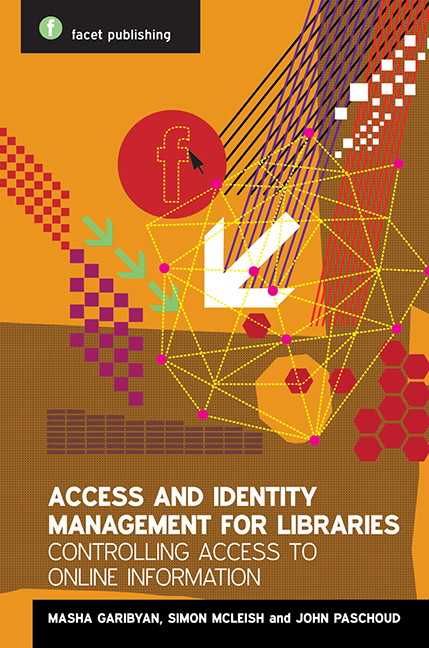Book contents
- Frontmatter
- Contents
- Foreword
- Acknowledgements
- Note to readers
- Glossary
- 1 What is access management, and why do libraries do it?
- 2 Electronic resources: public and not so public
- 3 Principles and definitions of identity and access management
- 4 Current access management technologies
- 5 Authentication technologies
- 6 Authorization based on physical location: how does the internet know where I am?
- 7 Authorization based on user identity or affiliation with a library: who you are? Or what you do?
- 8 Federated access: history, current position and future developments
- 9 How to choose access management and identity management products and services
- 10 Internet access provided by (or in) libraries
- 11 Library statistics
- 12 The business case for libraries
- Afterword
- Appendix 1 Case studies
- Appendix 2 A White Paper on Authentication and Access Management Issues in Cross-organizational Use of Networked Information Resources
- Index
1 - What is access management, and why do libraries do it?
Published online by Cambridge University Press: 10 September 2022
- Frontmatter
- Contents
- Foreword
- Acknowledgements
- Note to readers
- Glossary
- 1 What is access management, and why do libraries do it?
- 2 Electronic resources: public and not so public
- 3 Principles and definitions of identity and access management
- 4 Current access management technologies
- 5 Authentication technologies
- 6 Authorization based on physical location: how does the internet know where I am?
- 7 Authorization based on user identity or affiliation with a library: who you are? Or what you do?
- 8 Federated access: history, current position and future developments
- 9 How to choose access management and identity management products and services
- 10 Internet access provided by (or in) libraries
- 11 Library statistics
- 12 The business case for libraries
- Afterword
- Appendix 1 Case studies
- Appendix 2 A White Paper on Authentication and Access Management Issues in Cross-organizational Use of Networked Information Resources
- Index
Summary
A (very) brief history of the role of libraries in managing access to information resources, how this underpins what libraries do now and will do in the future, how their role has changed in recent history, and some seminal milestones in the invention of modern access and identity management principles.
Historical role of libraries in managing access to Information
I want a poor student to have the same means of indulging his learned curiosity, of following his rational pursuits, of consulting the same authorities, of fathoming the most intricate inquiry as the richest man in the kingdom, as far as books go …
(Select Committee on British Museum, 1836)These were the words of Sir Anthony Panizzi, arguably the greatest administrative librarian who has ever lived, in his vision for the British Museum Library in 1836. Panizzi was not, at the time, envisaging libraries giving people access to the wealth of information resources beyond books, as they do 170 years later. But perhaps we can now see with the benefit of hindsight that the most perceptive part of that statement may have been ‘as far as books go’. Because whilst libraries all over the world have long established their role in making access to books (and most other printed material) free and equal to all, they have not been able to achieve the same accessibility for the material delivered electronically, which already constitutes the majority by volume of information available from some libraries.
Since the first libraries existed, they have had two apparently conflicting purposes: to facilitate access to sources and records of scholarly knowledge; and to restrict such access. The oldest-established form of access management practised by libraries is still in use today in most of them. When information is contained in a printed book, it can be kept on a shelf (chained to it, if necessary) inside a secure building, and the entrance can be guarded to allow only known and authorized users into the building. A few examples of chained libraries still exist, such as the Hereford Cathedral Chained Library in the UK (www.herefordcathedral.org/educationresearch/ library-and-archives/history-of-the-chained-library).
- Type
- Chapter
- Information
- Access and Identity Management for LibrariesControlling Access to Online Information, pp. 1 - 8Publisher: FacetPrint publication year: 2014



